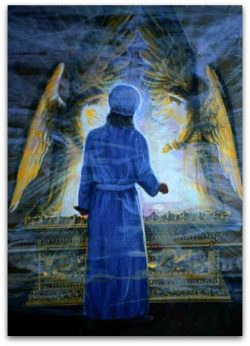I don’t pretend to be an expert on Yom Kippur, or on the process of tshuvah, repentance.
Like many of you, memories of Yom Kippur from my childhood were that shul was long, where invariably some elderly congregant would get weak and faint, someone ran to help with smelling salts, and an ambulance would come and take said congregant away. On Yom Kippur, everyone dressed to kill, but the collective bad breath of hundreds of people fasting for 25 hours is what really did you in. The day was an endurance test; you’d be looking at the clock, timing how long until the fast was over and you could eat. When the shofar would finally blow at the end, there would be a mad dash to the exits, while that guy would stand there and try and sing Hatikvah at the top of his lungs, in righteous indignation at all his coreligionists who had the chutzpah to decamp to their break-fast, instead of singing their allegiance to Israel. And while this would be going on, the shul regulars would be forcing their way towards the front of the sanctuary to pray ma’ariv, fighting the human tidal wave of starving yidden leaving their pews in the other direction to head home.
But a funny thing happens as you get older. The cartoonish nature of what I described above still occurs, but takes up less of your focus. You turn inward and more reflective with maturity. Yom Kippur becomes more interesting. You pay a bit more attention to what you are reading in the machzor, and look for meaning in the moments and the tunes, or niggunim. And if you are lucky, each year, you notice something that pulls you deeper into the time and space of Yom Kippur, the holiest day of the Jewish year.
I found my moment for this year, even before I step into synagogue tomorrow night. And I want to share it with you because I hope it becomes your moment as well.
Israeli megastar singer Ishay Ribo (great article about him here) just released “Seder Ha’avoda”, a song that recalls the service of the High Priest, the Kohen Kadol on Yom Kippur. It is a central part of the prayer service on Yom Kippur. Most of the lyrics of the song come straight from the liturgy of Yom Kippur.
I can’t stop listening to it.
You see, I’ve spent my whole life engaged in Jewish learning, as a student, teacher and now Head of School. I’ve studied broadly and I’ve studied in depth, on a wide range of subjects. In all those years, I’ve never “felt” anything when learning about the Yom Kippur service in the Beit Hamikdash. For sure, I learned about it, and I knew about the following part of our history, as per the Rambam, Maimonides:
Seven days before Yom Kippur, the Kohen Gadol (“High Priest”) is removed from his home to his chamber in the Holy Temple.
Mishneh Torah, Laws of the Yom Kippur Service, 1:3
[Upon concluding the Yom Kippur service, the Kohen Gadol] washed his hands and feet, removed the golden vestments, dressed himself in his own clothes, and set off for his home. The entire people would accompany him to his home. He would celebrate a festival over the fact that he had emerged in peace from the holy.
Ibid., 4:2
Despite all that learning, I never understood it on a kishke level until now, until Ribo brought it to life. He composed the song about two years ago while he himself was in synagogue on Yom Kippur, in the middle of the Musaf service. That an Israeli singer can release a pop song in September of 2019 about a Temple service that was last conducted over 2,000 years ago, and make you feel awe and amazement and a deep spiritual longing is something that I am repeatedly floored by, each and every time I listen to the song. Music as a vehicle for learning and understanding is a powerful force. “Seder Ha’Avoda” has completely changed my understanding of Yom Kippur.
Listen to it before the Fast begins, and let me know if it moves you too.
Have an easy and meaningful fast. Ktivah v’chatimah tovah.
Mar Abba
Head of School

